Related Research Articles
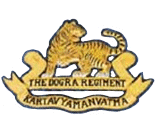
The Dogra Regiment is an infantry regiment of the Indian Army. The regiment traces its roots directly from the 17th Dogra Regiment of the British Indian Army. When transferred to the Indian Army like its sister regiments, the numeral prefix was removed. Units of the Dogra Regiment have fought in all conflicts that independent India has been engaged in, making it one of the most prestigious and most decorated regiments of the Indian Army.
The Dogras or Dogra people, are an Indo-Aryan ethno-linguistic group living primarily in the Indian union territory of Jammu and Kashmir and neighbouring Pakistan, consisting of the Dogri language speakers. They live predominantly in the Jammu region of Jammu and Kashmir, and in adjoining areas of Punjab and Himachal Pradesh. Some also live in northeastern Pakistan. Their historical homeland is known as Duggar.
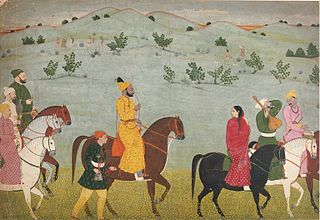
Jasrotia is a Dogra Rajput warrior clan from the Jammu region of India, of Suryavanshi lineage, following Hinduism.

The Rashtriya Rifles is a counter-insurgency force in India, formed in 1990, to specifically serve in the Jammu and Kashmir region. They also maintain public order by drawing powers from the Armed Forces Special Powers Act, 1990 (AFSPA). The RR was raised by the Indian Army by reconstituting two corps. Its personnel are provided by the Indian Army on deputation. The RR is commanded by an Additional Directorate General of Rashtriya Rifles.

Maharaja Gulab Singh Jamwal (1792–1857) was the founder of Dogra dynasty and the first Maharaja of the princely state of Jammu and Kashmir, the largest princely state under the British Raj, which was created after the defeat of the Sikh Empire in the First Anglo-Sikh War. During the war, Gulab Singh stayed aloof which helped the British victory, and even became prime minister of the Sikh Empire for the final 38 days of conflict. The Treaty of Amritsar (1846) formalised the sale by the British to Gulab Singh for 7,500,000 Nanakshahee Rupees of all the lands in Kashmir that were ceded to them by the Sikhs by the Treaty of Lahore.
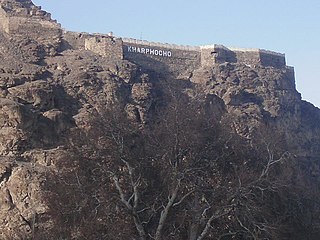
Skardu Fort or Kharpocho, meaning The king of Forts, is a fort in Skardu in the Gilgit-Baltistan region of Pakistan. Australian mountaineer and film maker Greg Child writes that the fort is "perched above the junction of the rivers" and overlooks the Rock of Skardu.

Zorawar Singh was a military general of the Dogra Rajput ruler, Gulab Singh of Jammu. He served as the governor (wazir-e-wazarat) of Kishtwar and extended the territories of the kingdom by conquering Ladakh and Baltistan. He also boldly attempted the conquest of Western Tibet but was killed in battle of To-yo during the Dogra-Tibetan war. In reference to his legacy of conquests in the Himalaya Mountains including Ladakh, Tibet, Baltistan and Skardu as General and Wazir, Zorowar Singh has been referred to as the "Napoleon of India", and "Conqueror of Ladakh".
Gurha Slathia is a village and notified area in the Samba district of the Indian union territory of Jammu and Kashmir. The village is the birthplace of some of the bravest men and women born in Jammu and Kashmir. The place is well known for its Amma ka Mandir where the Rajput families unite once a year.
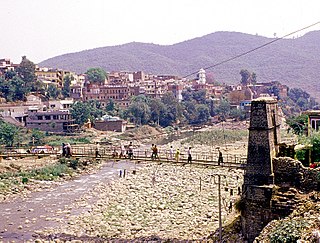
Rajouri or Rajauri is a city in the Rajouri district in the Jammu division of the Indian union territory of Jammu and Kashmir. It is located about 155 kilometres (96 mi) from Srinagar and 150 km (93 mi) from Jammu city on the Poonch Highway. The city is the location of the birthplace of Sikh General Banda Singh Bahadur. Baba Ghulam Shah Badshah University is also situated in this district.

The Namgyal dynasty was a dynasty whose rulers were the monarchs of the former kingdom of Ladakh that lasted from 1460 to 1842 and were titled the Gyalpo of Ladakh. The Namgyal dynasty succeeded the first dynasty of Maryul and had several conflicts with the neighboring Mughal Empire and various dynasties of Tibet, including the Tibet–Ladakh–Mughal War. The dynasty eventually fell to the Sikh Empire and Dogras of Jammu and Kashmir. Most of its known history is written in the Ladakh Chronicles.
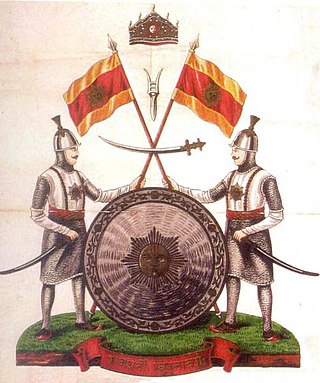
Jamwal is a toponymic surname for a Dogra Rajput clan of the same name from Jammu, in Jammu and Kashmir, India. They claim descent from the traditional founder of Jammu, Jambu Lochan, and there at one time some of their members were rulers of the princely state of Jammu and Kashmir, often referred to as the Dogra dynasty.
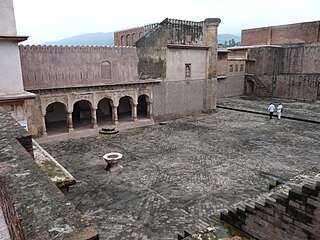
Ramnagar is a town and notified area committee in Udhampur District in the Indian union territory of Jammu and Kashmir.

The Dogra dynasty of Dogra Rajputs from the Shivalik hills created Jammu and Kashmir when all dynastic kingdoms in India were being absorbed by the East India Company. Events led the Sikh Empire to recognise Jammu as a vassal state in 1820, and later the British added Kashmir to Jammu with the Treaty of Amritsar in 1846. The founder of the dynasty, Gulab Singh, was an influential noble in the court of the Sikh emperor Maharaja Ranjit Singh, while his brother Dhian Singh served as the prime minister of the Sikh Empire. Appointed by Ranjit Singh as the hereditary Raja of the Jammu principality, Gulab Singh established his supremacy over all the hill states surrounding the Kashmir Valley. After the First Anglo-Sikh War in 1846, under the terms of the Treaty of Lahore, 1846, the British Indian government acquired Kashmir from the Sikh Empire and transferred it to Gulab Singh, recognising him as an independent maharaja. Thus, Jammu and Kashmir was established as one of the largest princely states in British India, receiving a 21-gun salute for its Maharaja in 1921. It was ruled by Gulab Singh and his descendants till 1947.
The Rakwal is a Rajput clan found mainly in the Indian states of Himachal Pradesh and Jammu and Kashmir, districts of Punjab like pathankot. Their immediate ancestor was King Raja Abta Deo of Jammu, who founded a principality in Sialkot. They are a Dogra sub-group, and their customs are similar to other Dogras Rajputs. Rakwal Rajputs are Suryavanshi Linage Rajputs of Jammu and Kashmir. The rakwal Rajputs intermarry with the Sulehria, Langeh, Andotra, Bhalwal, Baghal, lalotra, Manhas, Rana, Parihar, Jamwal, Rathore, Sambyal, Charak and Jaj.
The Lalotra is a Hindu Rajput clan found mainly in the Indian states of Punjab, Himachal Pradesh and Jammu and Kashmir. The Lalotra's were also found in Sialkot District, and these Lalotra's immigrated to India at the time of the Partition of India. They are a Dogra sub-group, and their customs are similar to other Dogras.

Brigadier Rajinder Singh Jamwal, MVC, also remembered as the Saviour of Kashmir, was an officer in the Jammu and Kashmir State Forces. He briefly served as the Chief of Staff of State Forces and died fighting during the First Kashmir War. Rajinder Singh and his small contingent of about 200 men successfully delayed the advance of a much larger force of Pakistani tribal raiders near Uri for several days, during which the Maharaja of Kashmir acceded to India and the Indian forces air-lifted for the defence of Kashmir.
The Battle of Jammu was fought between Sikhs and the Dogra Rajputs in 1808. The Dogras lost Jammu and Hukam Singh Chimni captured the Jammu city. This was a great success for the Sikhs as now their route to Kashmir was open. Kashmir was later on conquered by Sikhs under Misr Diwan Chand the Army chief of Maharaja Ranjit Singh in 1819. In 1820, the Sikhs had to install Gulab Singh as the Raja of Jammu and as a vassal to Ranjit Singh because of the growing revolt of the Dogra Rajputs against the Sikhs. Gulab Singh would go on to establish the Dogra dynasty.
72 Armoured Regiment is an armoured regiment of the Indian Army.
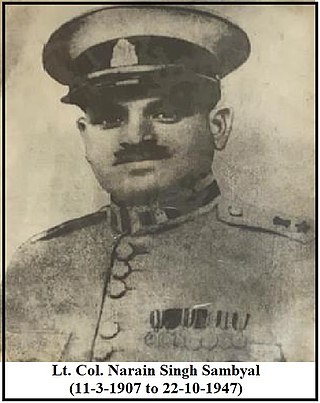
Colonel Narain Singh Sambyal, OBE, also remembered as the Savior of Kashmir, was a Commander of 4th Jammu and Kashmir State Forces who died fighting during the First Kashmir War at Domel Muzaffarabad.